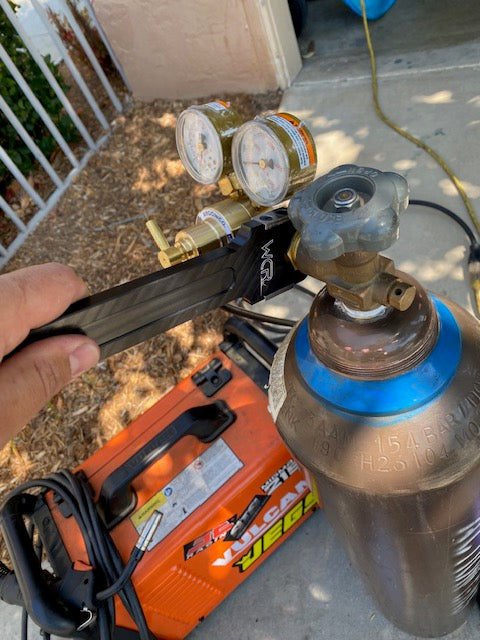Flow Meters vs. Regulators: What Welders Need to Know
If you’re serious about welding, you know that shielding gas control can make or break your weld quality. Too much gas and you waste money; too little gas and you risk porosity and weak welds. That’s where welding regulators and flow meters come in.
While they’re often talked about together, they actually do different jobs. In this guide, we’ll break down the differences, go over the types of regulators and types of flow meters, and help you figure out which setup is right for your welding projects.
What Is a Welding Regulator?
A welding gas regulator controls pressure from your gas cylinder. Welding gases like argon, CO₂, oxygen, or acetylene are stored at very high pressures — often over 2,000 PSI. That’s way too high for welding equipment to handle safely, so a regulator reduces it to a usable working pressure.
Main purpose: Reduce high cylinder pressure to a safe, consistent level for your welding process.

This is an example of a single stage regulator commonly used on most MIG welding setups. Note the rounded regulator nut. This comes from using steel tools on the soft brass hardware. Make sure you use a regulator wrench that is made from aluminum so you can increase the lifespan of your regulator!
Types of Welding Regulators
-
Single-Stage Regulators
-
Lower the cylinder pressure to working pressure in one step.
-
Simple, affordable, and easy to use.
-
Pressure can fluctuate slightly as the cylinder empties, so occasional adjustments are needed.
-
Great for short welding jobs or hobbyists.
-
-
Two-Stage Regulators
-
Reduce pressure in two steps for more accuracy.
-
Maintain steady pressure from start to finish, even as the cylinder pressure drops.
-
Ideal for TIG welding, precision work, or long production runs.
-
More expensive but longer lasting.
-
-
Specialty Regulators
-
Designed for specific gases or applications — like acetylene regulators for cutting, high-flow regulators for heavy-duty MIG welding, or low-pressure regulators for delicate TIG work.
-
What Is a Welding Flow Meter?
A welding flow meter measures and controls gas flow rate, usually in cubic feet per hour (CFH) or liters per minute (LPM).
Instead of reducing pressure, a flow meter makes sure the right volume of shielding gas is delivered to your MIG or TIG torch. This ensures your weld puddle is protected from contamination without wasting gas.
Main purpose: Deliver a consistent flow rate of shielding gas to the weld zone.

This is an example of a double flow meter. This allows you to run a backpurge using a separate tube for exotic metals like stainless steel and titanium
Types of Welding Flow Meters
-
Ball-Type (Float) Flow Meters
-
Most common for TIG and MIG welding.
-
Clear tube with a floating ball — as gas flows, the ball rises and you read the scale for CFH/LPM.
-
Accurate, durable, and easy to read.
-
-
Rotameter Flow Meters
-
Similar to ball-type but with a tapered tube.
-
Often used interchangeably with “ball flow meter.”
-
-
Electronic/Digital Flow Meters
-
Use sensors for precision gas measurement.
-
Display readings digitally for quick checks.
-
Great for high-volume production or automated welding.
-
-
Preset Flow Meters
-
Set to a fixed flow rate — no adjustments needed.
-
Ideal for repetitive production welding.
-
Do You Need a Regulator or a Flow Meter?
For most welding setups, you actually need both:
-
The regulator reduces high cylinder pressure to a usable level.
-
The flow meter fine-tunes and measures the exact gas flow rate.
Many MIG welders choose a single stage regulator, while TIG welders choose a flow meter
Choosing the Right Welding Gas Control Setup
-
MIG welding: Usually needs 20–35 CFH of gas flow — a single stage regulator is the most common solution.
-
TIG welding: Typically runs 10–20 CFH — accuracy matters, so a two-stage regulator with a flow meter is ideal. If you are backpurging stainless steels or titanium, a double flow meter is the best solution so you can plumb your backpurge line separately from your tig torch.
-
Oxy-fuel cutting/welding: Uses regulators, not flow meters, to control fuel gas and oxygen pressure.
Pro Tip: Always match your regulator and flow meter to the gas type. Argon fittings won’t work with oxygen or acetylene — and forcing them can be dangerous.
WCR Tools ArcLight Spanner Regulator Wrench
When you’re working with regulators, having the right tool to install and remove them quickly is a big time saver. The WCR Tools ArcLight Spanner Regulator Wrench is designed specifically for welding regulators, giving you a secure grip without damaging fittings.
Why welders love it:
-
Perfect fit for standard 1 1/8" regulator nuts and cylinder valves.
-
Aluminum Construction protects brass regulators from rounding out and damage during use.
-
Slim profile makes it easy to use in tight spaces.
-
Prevents rounding on brass fittings, extending regulator life.
- Replaceable cold chisel allows for multifunctional design to not only change regulators but also to remove slag from work.
Whether you’re swapping a regulator between cylinders or installing a new flowmeter regulator combo, the ArcLight Spanner welding regulator wrench is a must-have in your welding kit. It’s a small investment that protects your gear and saves time on every setup.
Final Word
Understanding the difference between welding regulators and flow meters is key to controlling your shielding gas, avoiding waste, and producing clean, strong welds. Whether you’re a hobby welder or running a fabrication shop, choosing the right setup will save you money and improve your weld quality.
If you’re looking for quality welding regulators, flow meters, or combination units, check out our selection at WCR Tools. We carry dependable, professional-grade equipment that works as hard as you do.
